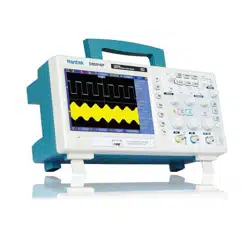Loading ...
Loading ...
Loading ...

Basic Operation
DSO5000P Series Digital Storage Oscilloscope User Manual 34
6
PRMS
Calculate the actual RMS measurement of the first complete cycle in
the waveform.
7
Min
The most negative peak voltage measured over the entire
waveform.
8
Max
The most positive peak voltage measured over the entire waveform.
9
Rising
Measure the time between 10% and 90% of the first rising edge of
the waveform.
10
Falling
Measure the time between 90% and 10% of the first falling edge of
the waveform.
11
+ Width
Measure the time between the first rising edge and the next falling
edge at the waveform 50% level.
12
- Width
Measure the time between the first falling edge and the next rising
edge at the waveform 50% level.
13
+ Duty
Measure the first cycle waveform. Positive Duty Cycle is the ratio
between positive pulse width and period.
14
- Duty
Measure the first cycle waveform. Negative Duty Cycle is the ratio
between positive pulse width and period.
15
Base
Measure the highest voltage over the entire waveform.
16
Top
Measure the lowest voltage over the entire waveform.
17
Middle
Measure the voltage of the 50% level from base to top.
18
Amplitude
Voltage between Vtop and Vbase of a waveform.
19
Overshoot
Defined as (Base - Min)/Amp x 100 %, Measured over the entire
waveform.
20
Preshoot
Defined as (Max - Top)/Amp x 100 %, Measured over the entire
waveform.
21
PMean
Calculate the arithmetic mean voltage over the first cycle in the
waveform.
22
FOVShoot
Defined as (Vmin-Vlow)/Vamp after the waveform falling.
23
RPRESoot
Defined as (Vmin-Vlow)/Vamp before the waveform falling.
24
BWidth
The duration of a burst measured over the entire waveform.
25
Delay 1-2 ↑
The time between the first rising edge of source 1 and the first rising
edge of source 2.
26
Delay 1-2 ↓
The time between the first falling edge of source 1 and the first
falling edge of source 2.
27
LFF
The time between the first falling edge of source 1 and the last
falling edge of source 2.
28
LFR
The time between the first falling edge of source 1 and the last rising
edge of source 2.
29
LRF
The time between the first rising edge of source 1 and the last falling
edge of source 2.
30
LRR
The time between the first rising edge of source 1 and the last
rising edge of source 2.
31
FFR
The time between the first falling edge of source 1 and the first
rising edge of source 2.
Loading ...
Loading ...
Loading ...
